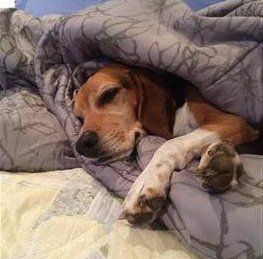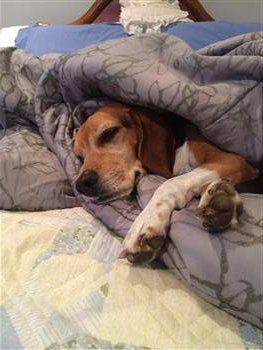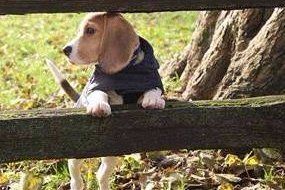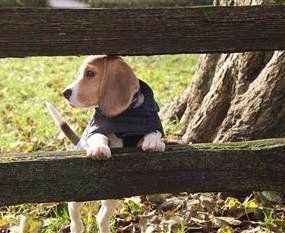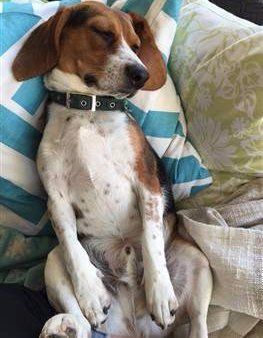Beagle Bad Breath
Overview
Halitosis, commonly referred to as bad breath, is not uncommon with dogs. But it is important to know that bad breath, though common, is not normal.
A dog's breath may have a particular smell such as sour, fishy, or even overly sweet or it may be hard to place; it may seemingly come and go at random or it may be a chronic, on-going concern.
And this is an issue that frustrates many owners as they try to pinpoint the cause. In many cases, curing bad breath with a Beagle will just be a matter of making a few changes. But in other cases, this can point to some issues that can turn quite serious without intervention.
This section will cover:
- All of the reasons why a Beagle may have bad breath
- Easy steps you can do from home to eliminate the odor
- Red flags that the halitosis may be pointing to a more severe health issue
Please note:
BeaglePro is reader-supported, and some of the product suggestions on this page are affiliate links. As an Amazon Associate we earn from qualifying purchases. This is at no extra cost to you and helps us keep this site running.
Reasons for a BeagleHaving Bad Breath
Reasons for a Beagle Having Bad Breath
There is a vast array of causes for halitosis in dogs; we will go over these in the order of most likely to rare yet possible.
1) Teething
– In regard to a Beagle puppy having bad breath, the #1 cause is teething.
This often begins around the age of 4 months old and lasts for several months.
So, fortunately, this is a temporary issue that will resolve itself once the teething phase
is complete.
In these cases, the pup’s breath will have an odor that can be compared to sour milk. The reason for this is the mix of blood (from teeth erupting) mixing with the pup’s saliva.
What to do:
While bad breath due to teething will resolve once all of the adult teeth are in place, there are some things that you can do to not only remove some of this odor but also to help relieve the discomfort and itching associated with this phase.
1. Clean your puppy’s teeth.
Far too many dogs suffer the effects of poor or lacking at-home dental care. It is never too early to start brushing the teeth and offering dental chews to keep plaque at bay.
Not only will this setup a foundation of good habits, the action of brushing can feel wonderful on itchy gums and it will clean away the blood/saliva mix that is the root of the bad breath, at least temporarily.
Use a great kit like the KissAble Toothbrush and Toothpaste Combo Kit
 . And for dental chews to keep teeth clean and breath smelling great, nothing beats Greenies.
. And for dental chews to keep teeth clean and breath smelling great, nothing beats Greenies.
Greenies Teenie
 is for pups up to 15 pounds and for dogs 15 to 25 pounds, you'll want to go with Greenies Petite
is for pups up to 15 pounds and for dogs 15 to 25 pounds, you'll want to go with Greenies Petite
 .
.
2. Encourage the use of teething toys and the ingestion of water.
No doubt, you have teething toys for your Beagle puppy, however if he is not using them it may be time to reassess what you have to offer to find effective toys that the pup enjoys.
Also, no doubt you leave water accessible at all times, however some Beagles need a bit of a nudge; making sure both the bowl is clean, the water is both clean and cool and even obtaining a canine water fountain can be ways to encourage a Beagle to drink enough to reach his needed daily water requirement
and this in turn, will help wash away the smelly mouth odors that can happen during this time.
2) Dog food particles
- If your Beagle’s breath smells like old, rotted dog food, it may be just that. This is particularly common with dogs that eat dry kibble.
There are 2 elements that can cause dog food
to led to foul breath.
The first is the level of dryness found in many kibbles and the second is that stale food compounds this issue.
When a Beagle eats dry food, it contains a certain level of dry powdered dust that coats the individual pieces; when stale this becomes even more of a problem.
When this mixes with the saliva in the Beagle’s mouth, it can form a rather thick paste. This food paste can then stick like glue to the crevices of teeth. Most often, drinking water is not enough to wash this smell away.
What to do:
There are 4 things you can do:
1. Avoid that last scoop in the bag, which will often be the one to contain the most powdered food dust, that turns to smelly paste if eaten.
Stone, at 9 years old
Photo courtesy of Michael Scott
2. Check the dates on your Beagle’s food bags.
If you notice that large bulk bags go past the date on a regular basis, you may want to purchase smaller bags or transfer the kibble to airtight plastic containers that will keep it fresh.
3. Encourage your Beagle to drink up, to help wash it all down. Most dogs do respond well to fresh cold water in a newly cleaned bowl. But if your Beagle needs more encouragement, a canine water fountain like Pioneer's Pet Stainless Steel Fountain
 will help; the noise of the falling water piques a dog's curiosity and can lead to him drinking more.
will help; the noise of the falling water piques a dog's curiosity and can lead to him drinking more.
4. Time the brushing of your Beagle’s teeth.
This is the #1 element to helping a Beagle have fresh breath and maintain it, and hopefully you do this every day. However, if your Beagle tends to have bad breath after dinner, choose that time to give those teeth a nice scrubbing.
Bentley, at 10 months old
Photo courtesy of C. Windust
3) Lack of Dental Care- Infection and other issues are a high concern (more ahead), however even without things progressing to that level, a buildup of bacteria and plaque can make a dog have quite terrible breath. Some equate it to smelling
like rotting fish, a super sour smell or even a musty odor.
While chewing on toys can help clean a dog’s teeth a bit, it does not come close to removing the daily buildup of plaque that naturally occurs.
There is nothing that an owner can do to stop plaque from developing; it happens around the clock. It is a colorless sticky film made up of sugars and bacteria. Once it builds up, it grows both thicker and extends, to under the gum line if it is allowed.
That alone can cause a Beagle to have very bad breath.
And the longer that it is not cleaned off, the smellier things will get. Eventually, it will cause decay and infections (see #4).
What to do:
It is important to note that if it has been some time since your Beagle’s teeth were checked or if you suspect plaque is under the gums or had been there long enough to harden into tartar, only a professional dental cleaning can remove it all and check to see if decay has occurred.
If these serious issues have been ruled out, you can:
1. Clean your Beagle's teeth - Give your Beagle's teeth and gums a thorough scrubbing using a quality, effective canine toothpaste and a quality toothbrush that is appropriately sized for your Beagle such as KissAble's Toothbrush and Toothpaste Combo Kit
 . This is a care task that should be done every day for at least 5 minutes.
. This is a care task that should be done every day for at least 5 minutes.
And once per day, give your Beagle an effective dental chew like Greenies Dental Dog Treats
 that works to get rid of plaque and bacteria, and freshen breath.
that works to get rid of plaque and bacteria, and freshen breath.
If your Beagle does require a ‘full dental’ with the vet, from that point on be sure to stay on schedule with
at home dental cleanings, making it part of the day’s normal schedule.
2. Follow all steps for preventing Beagle bad breath
(details ahead), which also includes effective dental treats, proper chew toys, sufficient water intake and even canine mouthwash.
4) Tooth Decay/Periodontal Disease
– As we mentioned above, a lack of cleanings (and sometimes even with them, if a dog is prone to issues), can lead to decay.
If so, this will cause chronic halitosis until the issue is resolved. This is something that owners should not ignore: Infection and decay can cause loose teeth, eventual tooth loss and the infection can spread. It may travel up into the sinuses and it may also travel throughout the body reaching vital organs such as the brain and heart.
And of course, all of this can be terribly painful for a dog that is not able to communicate this to his owner.
For a decayed tooth, either a root canal or an extraction will be recommended and for infections, antibiotics will be given.
5) Foreign Body
– If a Beagle has sudden acute bad breath, one possible reason is a foreign body in the mouth. For dogs that rummage around outside, this is not all that uncommon. Often thin wooden splinters can end up in a dog’s mouth, piercing the inner cheek or getting wedged in between teeth.
The mixture of blood and possible infection that can quickly set in, along with increased saliva production can cause the breath to hold a sour or bitter odor.
What to do:
With a helper, you can use a flashlight to take a look and see if you can visibly spot the culprit. If you do see something wedged in the teeth, you can try to remove it with your Beagle’s toothbrush, brushing in one direction as opposed to back and forth. With any sort of splinter in the mouth, the risk of removal at home is that just a piece will come out, leaving half of it in the tissue, so having a vet perform this is best.
6) If a Beagle’s Breath Smells like Poop
– If a dog’s breath literally smells like feces, this can be due to just that. While many owners catch their dogs doing this, a Beagle may have opportunities to eat his stools unseen.
If you let your Beagle out into the yard without supervision and he returns with stinky breath or if his breath smelled fine in the morning but you left him home alone and came back to breath that had a feces smell, there is a chance that he is having a coprophagia issue.
7) Medical Issues
– The above reasons for bad breath with a Beagle are the most likely causes. That said, there are some health issues
that have halitosis as one of the symptoms, though these do have other clear signs as well. Here are the most common:
Diabetes
– If a dog has breath that smells very sweet, often compared to smelling like fruit
or specifically a pear, this is one sign of diabetes. In addition, since this disease can cause issues with blood flow to the gums, this alone can lead to increased risk of periodontal disease.
It must be noted that diabetes is not just an issue with senior dogs; dogs of any age can be affected by this and the rates of occurrence have grown substantial in the last few decades; 1 out of every 160 canines will develop this.
Other signs aside from odd smelling breath include: changes in appetite, excessive thirst, changes in weight, increased urination, weakness, reoccurring UTI’s, lethargy, skin issues, vision problems and/or intestinal upset.
Lung Issues
– Any time that there is some sort of issue with the lungs, this can cause bad breath. Issue such as asthma, colds, bacterial or viral lung infections can cause a foul smell to come out with each breath. Be aware of such signs as the Beagle being out of breath after exercise, any wheezing and/or coughing.
Kidney Problems
– When a dog has breath that smells like urine, this points to possible issues with the kidneys; either stones or infection. In some cases, the odor will be so strong, it can be compared with ammonia. Along with the urine smell on the breath, other signs may include trouble urinating, blood in the urine and/or cloudy urine.
Stomach/Digestion/Intestinal issues
- Such things as burping up gas from the stomach can cause a dog to have bad breath that tends to smell acidy.
And upset stomach can cause bile to rise up far enough in the throat to affect the smell of the dog’s breath, even if he does not vomit. With gas issues, you may want to assess how fast your Beagle is eating; a slow feeder bowl may do the trick in slowing things down enough that he is not gulping air as he eats. For upset stomach, causes can range from allergies to worms, so a checkup is recommended.
Liver issues
– Most common with older, senior Beagles, decreases liver function or liver disease can have bad breath as a symptom, though this is certainly not the first sign that would be noticed and liver damage can occur even with young puppies.
Issues can stem from such things as ingestion of certain things (ragwort, certain mushrooms, blue-green algae and even certain molds that grow on corn, excessive ingestion of fatty foods), as a secondary issue to diabetes or from heartworms, among other things.
Signs of problems with the liver include: loss of appetite, vomiting, diarrhea, increased thirst, increased urination, confusion, lethargy, wobbly gait and/or a swollen abdomen.
4 Top Ways to Prevent Bad Breath with Beagles & Keep Breath Smelling Fresh
There are 4 easy steps to ensure that your puppy or dog will never have super stinky breath again (as long as tooth decay and any other possible health issues are ruled out). And, if you follow all of these steps, your Beagle can have either neutral smelling breath, if not outright minty clean.
1. Brush your Beagle teeth daily, with the right products.
Committing to a daily routine and using the right products will keep bad breath away and can also literally save your Beagle’s life by helping to prevent tooth decay (known as a silent killer). You’ll want to use a high quality canine toothpaste that is gentle on the enamel but effective enough to properly clean away plaque.
If you use one that tastes pleasant to your Beagle, this is all the better; he won’t want to run away
and since he’ll be swallowing the paste, he may actually enjoy it. Made in the USA products flavored with natural ingredients such as vanilla and tea tree oil are recommended. Please never use human paste, as fluoride is highly toxic to canines.
2. Give a daily dental treat.
With a quality dental chew, your Beagle will have no idea that you’ve given him something to help clean his teeth and make his breath smell nice; it can be your secret. We suggest swapping out a ‘regular’ treat for a dental treat at least 1 time per day. L
Nothing can really beat Greenies; These are the #1 vet recommended dental chew, and were the first to receive the Seal of Acceptance for control of plaque and tartar from the Veterinary Oral Health Council. Dogs tend to love how they taste, and they can be found in several varities, including grain-free and weight control.
3. Water supplement – canine mouth wash.
Our Beagles can’t compete with what we’re able to do for oral hygiene; they simply cannot swish and spit. However, canine mouth washes do exist; these are added to water and serve 2 purposes: they can kill bacteria that is in the water bowl and they can protect against the advancement of moderate to severe periodontal issues.
The one that we recommend by Dental Fresh, is flavorless, just a teaspoon is added per 1 cup and it has rave reviews by hundreds of dog owners, most of them happily shocked by how well this rids a dog of bad breath.
4. Reassess toys.
You may have tons of toys for your Beagle, but how many of those does he actually use? If your answer is “not many”, it may be time to do a ‘keep and don’t keep’, getting rid of the ones he ignores and stocking up on a few quality toys
that he’ll pay attention to.
Dogs of all ages love to chew and the increase of saliva that occurs during the chewing process can help prevent Halitosis.

